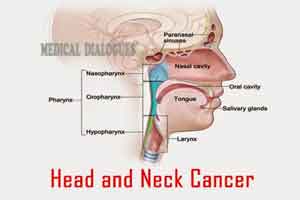- Home
- Editorial
- News
- Practice Guidelines
- Anesthesiology Guidelines
- Cancer Guidelines
- Cardiac Sciences Guidelines
- Critical Care Guidelines
- Dentistry Guidelines
- Dermatology Guidelines
- Diabetes and Endo Guidelines
- Diagnostics Guidelines
- ENT Guidelines
- Featured Practice Guidelines
- Gastroenterology Guidelines
- Geriatrics Guidelines
- Medicine Guidelines
- Nephrology Guidelines
- Neurosciences Guidelines
- Obs and Gynae Guidelines
- Ophthalmology Guidelines
- Orthopaedics Guidelines
- Paediatrics Guidelines
- Psychiatry Guidelines
- Pulmonology Guidelines
- Radiology Guidelines
- Surgery Guidelines
- Urology Guidelines
New guidelines for assessing severity of head and neck cancers

Cedars-Sinai investigators have developed a new, more accurate set of guidelines for assessing the severity of head and neck cancers and predicting patient survival.
The new guidelines, outlined in a study recently published in the Journal of Clinical Oncology, center around counting the number of malignant lymph nodes found in each patient.
"The greater the number of malignant lymph nodes, the less favorable the patients' chances of survival," said Allen S. Ho, MD. Ho is director of the Head and Neck Program at the Samuel Oschin Comprehensive Cancer Institute at Cedars-Sinai and lead author of the study. "This new approach could dramatically simplify staging systems."
For decades, doctors have determined the stage and predicted the progression of head and neck cancers based primarily on nodal size, location and how far cancer has spread beyond the lymph nodes, but they have given less importance to the number of cancerous nodes. As a result, staging and treatment recommendations, based on current national guidelines, "are the same whether a patient has two or 20 positive lymph nodes," said Zachary S. Zumsteg, MD, assistant professor of Radiation Oncology at Cedars-Sinai and the study's senior author.
With the new system, based on the number of cancerous lymph nodes, patients are separated into similarly sized groups with distinct outcomes, Zumsteg said. "Our study demonstrated a better way to assess cancer severity, which will improve our ability to predict outcomes and give patients more personalized treatment."
The Cedars-Sinai study involved reviewing data of 14,554 U.S. patients identified in the National Cancer Database who were treated for squamous cell carcinoma of the oral cavity (mouth, gum and tongue) between 2004 and 2013.
The data showed that an increased risk of death was associated with each additional cancerous lymph node found. The investigators concluded that the number of cancerous lymph nodes is a predominant, independent factor associated with death in those patients. The study also identified an ultra-high-risk group of patients with five or more cancerous lymph nodes.
Head and neck cancers occur in the lips, tongue, gums, bottom of the mouth, throat, larynx, nasal cavity and salivary glands. About 63,000 people developed head and neck cancers in the U.S. in 2017. More than 13,000 deaths from those cancers occurred during that period, according to the American Society of Clinical Oncology.
"Although considering the number of cancerous lymph nodes in staging is a simple concept that many head and neck cancer specialists have assumed to be true for years, data has been limited until now," Zumsteg said. The study authors said they hope that, based on the new data, the number of positive nodes in staging will now be incorporated into clinical practice.

Disclaimer: This site is primarily intended for healthcare professionals. Any content/information on this website does not replace the advice of medical and/or health professionals and should not be construed as medical/diagnostic advice/endorsement or prescription. Use of this site is subject to our terms of use, privacy policy, advertisement policy. © 2020 Minerva Medical Treatment Pvt Ltd